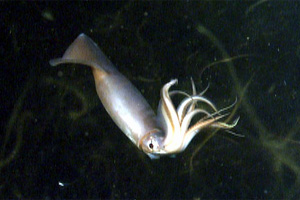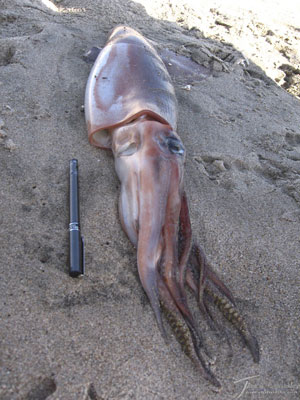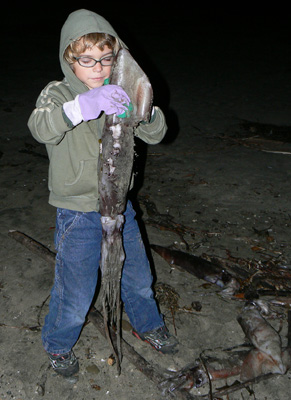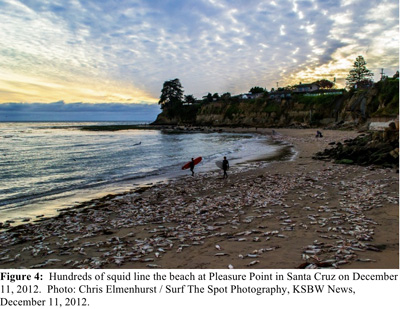
Humboldt squid, also called Jumbo squid, have recently expanded their range northward from Baja and southern California, and periodically wash ashore on central California beaches.
FACTS
- Humboldt squid are large, voracious predators commonly found in Baja and southern California.
- Little is known about Humboldt squid since they typically occur below 200 m and are highly mobile.
- Skin color can rapidly change from red to white, which may be a form of communication.
- Growth is very rapid, from a few mm up to 2 m, often in one year.
- Lifespan is only 1-2 years.
- Jumbo squid or Jumbo Flying squid are other commonly used names for Dosidicus gigas.
Recent Humboldt squid stranding events in and adjacent to Monterey Bay National Marine Sanctuary:
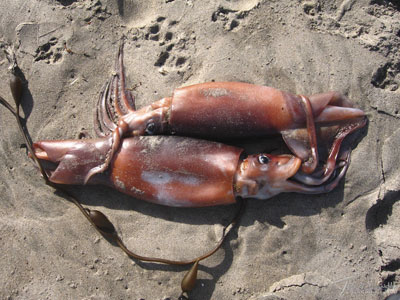
October-December 2012
One of the first observations occurred on October 9 in Pacific Grove (see video in links section below). Sightings continued throughout October and November, with beachings at Point Pinos from November 24-26. Volunteers in the Beach COMBERS program noted the squid on several beaches. The largest stranding to date occurred on beaches around Santa Cruz and began on December 9 (Figures 1-3). Hundreds of squid were observed near Pleasure Point, around Hidden Beach in Aptos, and from Seascape Beach to Manresa State Beach (Figure 4). One observer found that most of the stranded squid measured 60-70 cm long including tentacles, and were scattered across the beach in groups 1-8. Dr. Melissa Miller of the Department of Fish and Game will be sampling some of these squid for the presence of domoic acid.
October 2003
On the morning of October 10, a dozen Humboldt squid were found stranded on the beach at Stillwater Cover in Pebble Beach (Figure 5). The squid were over 5 feet long, weighed as much as 10 pounds, and had a distinctive red-purple coloring and huge eyes, shocking locals who had never seen anything like them. Many of the creatures were still alive when people found them; despite rescue efforts, all of the squid died. USGS researchers collected several specimens from this event and found that the squids’ stomachs contained juvenile pacific hake otoliths.
Background
Sightings of stranded Humboldt squid (Dosidicus gigas) have become increasingly common in the last several decades, and have occurred as far north as the beaches of Mendocino County. First recorded in Monterey Bay in 1935 (CA Fish Bulletin #49), sightings were infrequent until the 1997-98 El Niño event, when Humboldt squid were reported in greater numbers near the Monterey Canyon. Dr. William Gilly of Stanford University, an expert on the Humboldt squid, believes that shifts in prey availability prompted the squid to inhabit the Monterey Canyon.
While the cause of death of stranded squid is unknown, evidence points to neurological damage. Some researchers think that they die from eating fish and krill that fed on toxic algal blooms. Some plankton blooms produce harmful toxins, such as domoic acid, that are concentrated as they move up the food chain, potentially affecting the squid’s nervous system.
The Humboldt squid can reach 2 m in length and is a voracious predator, with strong arms and tentacles, keen vision, and an extremely sharp beak. Video footage has been captured from remotely operated vehicles that show Humboldt squid hunting fish near Cordell Bank. Researchers have observed coordinated hunting behavior among the squid, yet they are also known to be cannibalistic (hence the nickname “red devil”). While their skin is generally reddish-purple, they can rapidly change color by opening and closing chromatophores (i.e. pigment-filled sacs) in their skin. This behavior is controlled by the brain and is thought to be a form of communication, though no one knows exactly what the color changes mean.
The vast majority of the squid’s life is spent between 200 and 700 m below the sea surface, well beneath depths that can be reached by SCUBA divers. It has therefore been difficult for researchers to learn about the life cycle of these organisms. Fortunately, Humboldt squid often feed near the surface at night; researchers like Dr. Gilly have studied them during these times. His group has also tagged several of the animals in the Sea of Cortez, demonstrating that the squid migrate seasonally as much as 100 miles. Tagging experiments also indicate that the squid can tolerate an incredible range of depth, temperature, and dissolved oxygen conditions. As a result of this exceptional habitat range, it is most likely that Humboldt squid migration is primarily motivated by availability of food, rather than fluctuations in oceanic conditions. Yet, the distribution of the squid may be secondarily controlled by oceanic parameters, because these often dictate the location of the squids’ prey.
Dr. Gilly believes that the Humboldt squid are a prolific species for their size; he estimated that as many as 10 million may be living in a 25 square-mile area off Mexico. This implies that their population is enormous, given that they range latitudinally from California to Chile and longitudinally from Mexico halfway to Hawaii. They are an important part of the ocean food web, preying upon small fishes and krill and being preyed upon by sperm whales and large fishes, such as marlin and swordfish. In addition, they are vital to the fishing industry of Mexico, which sells tons of Humboldt squid to markets in Japan. Understanding the life cycle and distribution patterns of the Humboldt squid is vital to managing the fishery.
Links to More Information
- The lab of Stanford faculty Dr. William Gilly;
- Dr. Gilly and others encounter the Humboldt Squid while exploring the Sea of Cortez;
- Humboldt Squid covered by National Geographic;
- An article in The Carmel Pine Cone highlighting the 2003 stranding event;
- A video of some of the first Humboldt squid observed during the 2012 stranding event. Footage was taken on October 9, 2012 below 13th Street in Pacific Grove by YouTube user oceanfoxx;
- An article in the San Jose Mercury News discusses the 2012 stranding event;
- An article in Scientific American (Dec 2012) about why squid may strand;
- A KSBW News piece on the 2012 stranding event;
- Behavioral Ecology of Jumbo Squid (Dosidicus gigas) in Relation to Oxygen Minimum Zones (scientific paper);
- Humboldt Squid in the California Current. Julia Stewart, Hopkins Marine Station of Stanford University. (Abstract);
- Video clip of Humboldt squid hunting fish at Cordell Bank. Video provided by Cordell Bank National Marine Sanctuary. Launch video (8.8 Mb WMV file)
